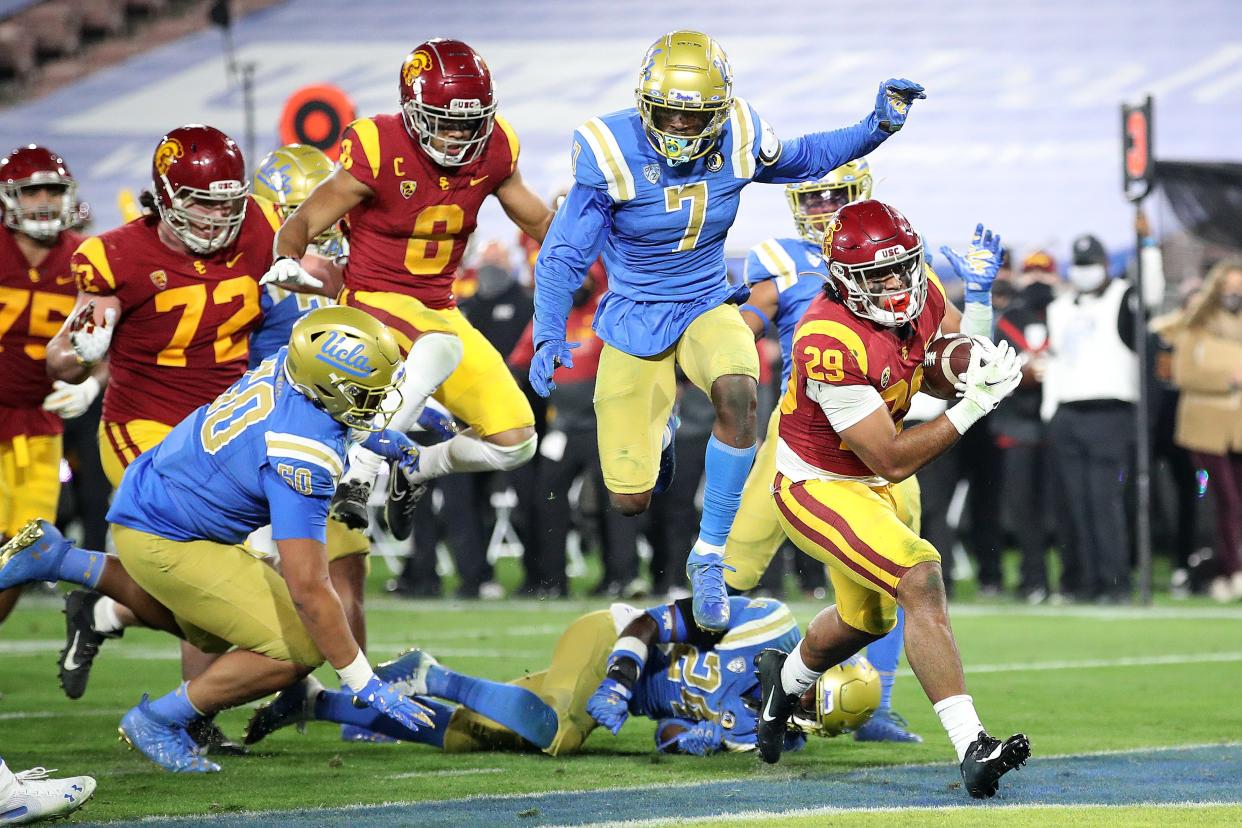Couch: 4 quick takes on USC and UCLA joining the Big Ten, what's next and what it means for Michigan State

1. For the Big Ten, adding USC and UCLA is a ruthless power play. But probably wise.
USC and UCLA joining the Big Ten, for you, the Michigan State fan, might be kind of thrilling ... or nauseating. Or somewhere in-between. As one friend repeatedly muttered Thursday: "It just seems unnecessary."
To me, it's all of those things. And also, given the climate in major college athletics, a little bit necessary.
In a world where geography matters, where coaches are paid reasonably, where athletes are content with their circumstances (or at least are powerless to change them), and schools like Texas and Ohio State and USC are satisfied with having plenty, this West Coast Big Ten expansion is, indeed, entirely unnecessary.
That’s not our world. In 2022, in major college athletics, you either get ahead of change or risk having to deal with it. This is the Big Ten taking the wheel, even if the conference’s first maneuver ruthlessly plowed over many of its peers around the country.
That’s someone else’s problem. For MSU and its Big Ten brethren, what’s transpiring — and far from finished — is a boon to athletic departments and conference stability, to student-athlete experience and resources, to expanded recruiting, to alumni and donor relations, and in the Big Ten’s bicep-flexing contest with the Southeastern Conference. “You got Texas and Oklahoma, huh? Psh. Check this out.”
The Longhorns and Sooners leaving the Big 12 rocked the Big 12. USC and UCLA leaving the Pac-12 rocks every major conference that isn’t the Big Ten or SEC.
2. The Big Ten isn’t done expanding
The addition of USC and UCLA puts the Big Ten at 16 members beginning in 2024. That’s not where this stops. You’ll see more expansion within the next year. The Big Ten can and will be choosy. It is one of two destination conferences. This isn’t just about athletic brand, academic prowess or media market alone. As I understand it, any school will have to be an American Association of Universities (AAU) member — with the exception of Notre Dame — and fit the conference’s graduate research requirements AND also bring value as an athletic brand.
The AAU includes 63 universities in the United States that describe themselves as “on the leading edge of innovation, scholarship, and solutions that contribute to scientific progress, economic development, security, and well-being.” The AAU doesn’t care that Clemson plays good football. Every Big Ten school is part of the AAU, other than Nebraska, which lost its membership shortly after being admitted to the Big Ten.
With that in mind, these are the possibilities: Stanford and Notre Dame (which would make a great next pairing), Oregon, Washington and maybe Colorado.
Notre Dame, which is caught in a time warp, would find the Big Ten membership far more lucrative than its current NBC deal, which pays the school $15 million annually for exclusive rights to its home games. The Big Ten was reportedly hoping its next contract, set to be announced in a few weeks, would net north of $70 million a school — and that was before it had USC (a national brand) and UCLA and the Los Angeles market. That Big Ten TV deal might also include NBC. Notre Dame is one to watch, especially as more of its traditional rivals join the Big Ten.
For the others, it’s not just about being an AAU member. You’re not going to see Cal in the Big Ten. There’s no oomph in Cal athletics.

Outside of the Pac-12, Pittsburgh, Virginia and North Carolina are fits, but under a strict and long-term Atlantic Coast Conference grant of rights deal that might be inescapable. That’s about it, unless the Big Ten wanted Kansas from the Big 12. It’s hard to imagine men’s basketball driving such a move.
Don’t expect the Big Ten to go beyond 20 teams, in the short term, if it gets to 20 at all. An understanding exists that there is such a thing as too many schools.
But there’s also a chance that, at the end of all of this, whenever that may be, it’s pretty much just two giant power-five football leagues standing: The Big Ten and SEC. And that the Big Ten doesn’t feel much like a conference at all, but rather a conglomerate of somewhat like-minded universities, brought together by football.
3. What this means for the Big Ten’s football divisions
This round of Big Ten expansion might seem like the end of thinking about doing away with divisions in football. After all, it’s a lot of teams not to be divided in some way. And you could make the argument for MORE divisions. If you’ve got 20 teams, perhaps have four five-team divisions, with each school playing its four divisional opponents and six others from the other three divisions. Who needs three non-conference games if half of college football is in your conference?
You could have a Pacific Division (you know, almost a Pac-12), with USC, UCLA, Stanford, Washington and Oregon. Of course, how you determine an overall Big Ten champion could get interesting in this case.
However, there is also still the sentiment to move away from divisions and that could be done a number of ways. If the Big Ten sits at say 18 teams for any length of time, each school could have three protected rivals it plays each year and then play the other 14 teams over two years, as part of a 10-game conference schedule each season. This would be one division-less option, similar to what the ACC just adopted.
The Big Ten could also go with fewer than three protected rivals and keep its league schedule at nine games or choose to get through the schedule rotations more quickly.
The schedules won’t be entirely balanced or seem fair. But for the teams in the East Division playing Ohio State every year, the divisions don’t seem all that fair right now, either.

4. This is a win for MSU. Almost entirely.
For an MSU athletic department without infinite resources, the addition of USC and UCLA — and whatever other schools follow — will only help the bottom line.
The Big Ten should now be the most marketable conference in the country again and its next television deal will reflect that. If its winds up paying out around $70 million per school annually, that’s about double the current deal. And for a program jostling to play football with the biggest of the big boys and a department trying to elevate the experience and winning of its non-revenue sports, money matters.
USC and UCLA will bring new eyeballs and more revenue — to everyone.
It’ll allow MSU to regularly connect with and engage its donors on the West Coast, to play in the Rose Bowl somewhat regularly (since that's dead now as a traditional Big Ten-Pac-12 bowl game anyway). It’ll allow MSU’s coaches, Mel Tucker on down the line, to more effectively recruit athletes in California, with the understanding that they’ll play at home a couple times during their careers and that their games are more likely to be on TV there, once the Big Ten Network nestles its way into Hollywood.
The overall brand of the Big Ten, with the addition of USC especially, is larger and stronger, and that can’t hurt endorsement opportunities for athletes.
Yes, there will be a few 10 p.m. eastern time tipoffs and kickoffs that are inconvenient — for viewers back home especially. That’s nothing MSU hasn’t done before when visiting schools out west. That’ll be infrequent anyway. You’re talking about one football game a year, maximum. Two basketball games a year, tops. The league should makes sure its student-athletes aren't taking midweek flights home overnight.
If travel for student-athletes concerns you, though, consider that it’s easier for MSU’s softball team to get to Los Angeles than it is to Iowa City. MSU’s soccer teams will play both USC and UCLA on the same trip. That’s a great trip. It is for any athlete, some of whom might never travel out that way otherwise.
Most of the travel burden will fall on UCLA and USC, who will be taking regular flights to the Midwest, experiencing noon ET kickoffs in West Lafayette and snowy fields in East Lansing. That’s their problem. And probably worth it, considering the financial upgrade to the Big Ten.
The only drawback for MSU: It just got a little harder to win the league.
MORE: Couch: Mel Tucker is in 'a race against time' to turn Michigan State football into a champion
MORE: Alan Haller's journey to becoming MSU's AD was formed by the family and community that raised him
Contact Graham Couch at gcouch@lsj.com. Follow him on Twitter @Graham_Couch
This article originally appeared on Lansing State Journal: USC and UCLA join the Big Ten: What's next and what it means for MSU

